
The northern rough-winged swallow is a small, migratory swallow. It is very similar to the southern rough-winged swallow, Stelgidopteryx ruficollis.
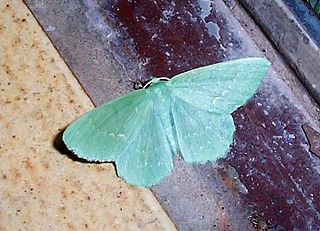
The large emerald is a moth which is the type species for the family Geometridae. It is found throughout the Palearctic region and the Near East in and around deciduous forests, heathlands, marshland and in settlements close to woodland. The species was first described by Carl Linnaeus in his 1758 10th edition of Systema Naturae.
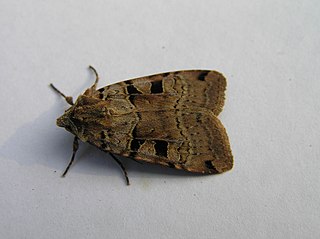
The double square-spot is a moth of the family Noctuidae. It is distributed through most of Europe except Portugal, the Mediterranean islands and northernmost Fennoscandia. In the East, the species ranges East across the Palearctic to Siberia and in the South-East to the Black Sea and in Iran. It rises to a height of about 2000 metres in the Alps.

Melanargia galathea, the marbled white, is a medium-sized butterfly in the family Nymphalidae. Despite its common name and appearance, this butterfly is one of the "browns", of the subfamily Satyrinae.
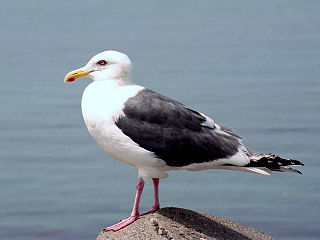
The slaty-backed gull is a large, white-headed gull that breeds on the north-eastern coast of the Palearctic, but travels widely during nonbreeding seasons. It is similar in appearance to the western gull and the glaucous-winged gull. Another alternate name is Pacific gull, though it also applies to a Southern Hemisphere species, L. pacificus.

Epiblema scutulana is a moth of the family Tortricidae. It is found in the Palearctic realm. The species closely resembles Epiblema sticticana and Epiblema cirsiana, identification is only possible on the basis of microscopic examination of the genitalia.

Synanthedon tipuliformis, known as the currant clearwing, is a moth of the family Sesiidae. It is endemic to the Palearctic realm, but is an invasive species in the Nearctic realm and the Australasian realm.

Thalera fimbrialis, the Sussex emerald, is a species of moth of the family Geometridae. It is found in Europe and across the Palearctic up to the area surrounding the Amur River.

Eupithecia tantillaria, the dwarf pug, is a moth of the family Geometridae. It was described by Jean Baptiste Boisduval in 1840. The species can be found in the Palearctic realm.

Agrochola litura, the brown-spot pinion, is a moth of the family Noctuidae. The species was first described by Carl Linnaeus in 1761. It is found in Europe and the Middle East. It is possibly also present in North Africa, but this is unclear because similar looking species Agrochola meridionalis is found there.

Pammene aurana is a moth of the family Tortricidae.

Eupithecia pygmaeata, the marsh pug, is a moth of the family Geometridae. It is known from most of Europe, western and southern Siberia, the Russian Far East, northern Mongolia and North America .The species primarily colonizes floodplain and disused forests, bogs, river banks and marshy meadows. E. pygmaeata reaches up to 1800 meters in South Tyrol.

Cosmopterix scirpicola is a moth of the family Cosmopterigidae. It is known from the United States, where found from Maryland and eastern Wyoming to Florida, south-western Louisiana and California. It has also been recorded from Alabama.
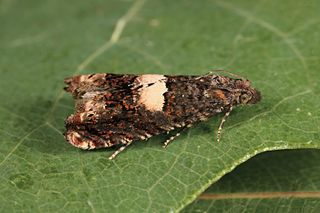
Epiblema sticticana is a species of moth of the family Tortricidae described by Philogène Auguste Joseph Duponchel in 1842.

Caryocolum fraternella is a moth of the family Gelechiidae. It is found in Ireland, Great Britain, Fennoscandia, Denmark, Germany, the Netherlands, France, Switzerland, Spain, Latvia, Estonia and Ukraine.

Falseuncaria ruficiliana, the red-fringed conch, is a species of moth of the family Tortricidae. It is found in China (Xinjiang) and most of Europe. The habitat consists of limestone, heathland and moorland.

Epiblema graphana is a species of moth of the family Tortricidae. It is found in Spain, France, Germany, the Benelux, Denmark, Austria, Switzerland, Italy, the Czech Republic, Slovakia, Poland, Norway, Sweden, Finland, the Baltic region, Albania, Romania, Bulgaria, Hungary, Slovenia, North Macedonia, Greece, the Near East, Russia, Kazakhstan, Iran, Afghanistan and China.
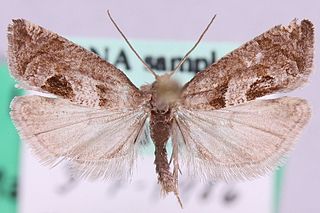
Epiblema junctana is a species of moth of the family Tortricidae. It is found in Sweden, Denmark, Germany, Austria, the Czech Republic, Slovakia, Poland, Bulgaria, Romania, Hungary, Ukraine, the Near East, Russia, Kazakhstan, Iran, Central Asia and China (Henan).

Thiodia citrana, the lemon bell, is a species of moth of the family Tortricidae. It is found in China, Japan, Iran, Asia Minor, Turkmenistan, Russia, Kazakhstan, North Africa and Europe. The habitat consists of rough grasslands and dry pastures.

Epiblema costipunctana is a species of moth belonging to the family Tortricidae. It is native to Europe.


















